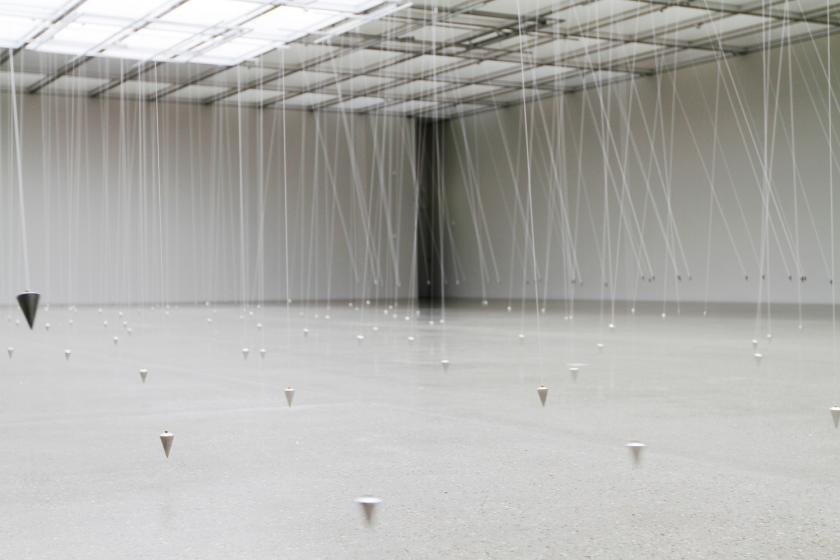On the morning I visited William Forsythe's installation there was a fire truck parked up on Circus Street. Its crew were all in the Old Municipal Market, taking in the art and, like everyone else, interacting with the kinetic sculptural elements. It is the stuff of arts outreach programme fantasies.
Forsythe is an American choreographer and sculptor who lives and works in Germany. He made his name at the helm of Ballet Frankfurt and has since proved himself an able visual artist, along with a radical director. Nowhere and Everywhere at the Same Time No 2 previewed in Essen, began life as a piece for professional dancers, and enjoyed performances in London, New York and Venice.
Introducing a grid of hazardous pendulums, it was a daring format for a dance performance. And yet the director went further; he gave them a political spin. "Nowhere and everywhere at the same time" was an operational mental state of freedom fighter Jacques Lusseyran who, despite blindness, joined the French Resistance during World War II. Forsythe has said the titular phrase can also refer to gravity.
The dancer-less version comes to Brighton at the invitation of Hofesh Shechter, fellow choreographer and guest curator of the city’s annual festival. Dance has come to the fore in this coastal town and the Municipal Market is soon to be redeveloped to house South East Dance and include a performance space for the art form.
No back story is needed to enjoy a large-scale installation which sets this cavernous space in motion. Some 400 pendulums, suspended at around a foot above the concrete floor, are flowing back and forth. Each is attached to an automated rig overhead.These several rigs run according to an unknowable program which alternates between calm and tumult. Looking out over this carpet of inverted metal cones you are put in mind of a swimming pool wave-machine. It is about as much fun.
Visitors are invited to leave bags to one side and get amongst the action. It hardly warrants me pointing it out, but this artwork makes you highly aware of your body and the space you occupy. To avoid the swinging cones requires peripheral vision and some unconscious geometric workings-out. To step into the pendulous swell is to feel like a performer. You may find yourself darting into space, pulling up on tiptoes, pivoting and changing direction. A purposeful stride just won’t cut it.
But what is dance without music? Voices get lost in this vast interior and the pervading sound comes from the travelling overhead grids, which hiss and clank. They set an industrial tone which sits well in this derelict interior. Yellow paint, the colour of parking controls, demarcates the edges of the piece. Uneven floors complete the scene and the result is much grittier than the average ballet. It is an unlikely stage with an unlikely soundtrack and unlikely performers.
Forsythe has a reputation for theorising and can back up his interventions with post-structuralist rationales. He is reportedly keen on Derrida, whose most famous claim, "There is nothing outside the text", folds the spheres of gesture and choreography into the field of text. So now, at last, movement can be deconstructed, as if to enter this maze of pendulums is to come out the other side in pieces.
Certainly this viewer came through the tide of metal spikes with a feeling of uncharacteristic agility. Pacing between the pendulums is a pleasurable experience in which you need to relinquish control and go with the varying flow. Some directions are easier than others. You choose your own level of risk, and as already hinted at, the experience is one of thinking with your whole body.
And the pendulums are also metronomic, which means the hall is in motion to a number of rhythms at once. Stepping into the mix is to have an experience at many different speeds at once. It is to feel in your sinews that time is not straightforward and linear. These are powerful propositions but, happily, it's not necessary to engage with them to enjoy the piece.
Overleaf: Catch a glimpse of William Forsythe's Nowhere and Everywhere at the Same Time No.2 courtesy of a short Festival promo film










![SEX MONEY RACE RELIGION [2016] by Gilbert and George. Installation shot of Gilbert & George 21ST CENTURY PICTURES Hayward Gallery](/sites/default/files/styles/thumbnail_125_x_125_/public/mastimages/Gilbert%20%26%20George_%2021ST%20CENTURY%20PICTURES.%20SEX%20MONEY%20RACE%20RELIGION%20%5B2016%5D.%20Photo_%20Mark%20Blower.%20Courtesy%20of%20the%20Gilbert%20%26%20George%20and%20the%20Hayward%20Gallery._0.jpg?itok=3oW-Y84i)




Add comment